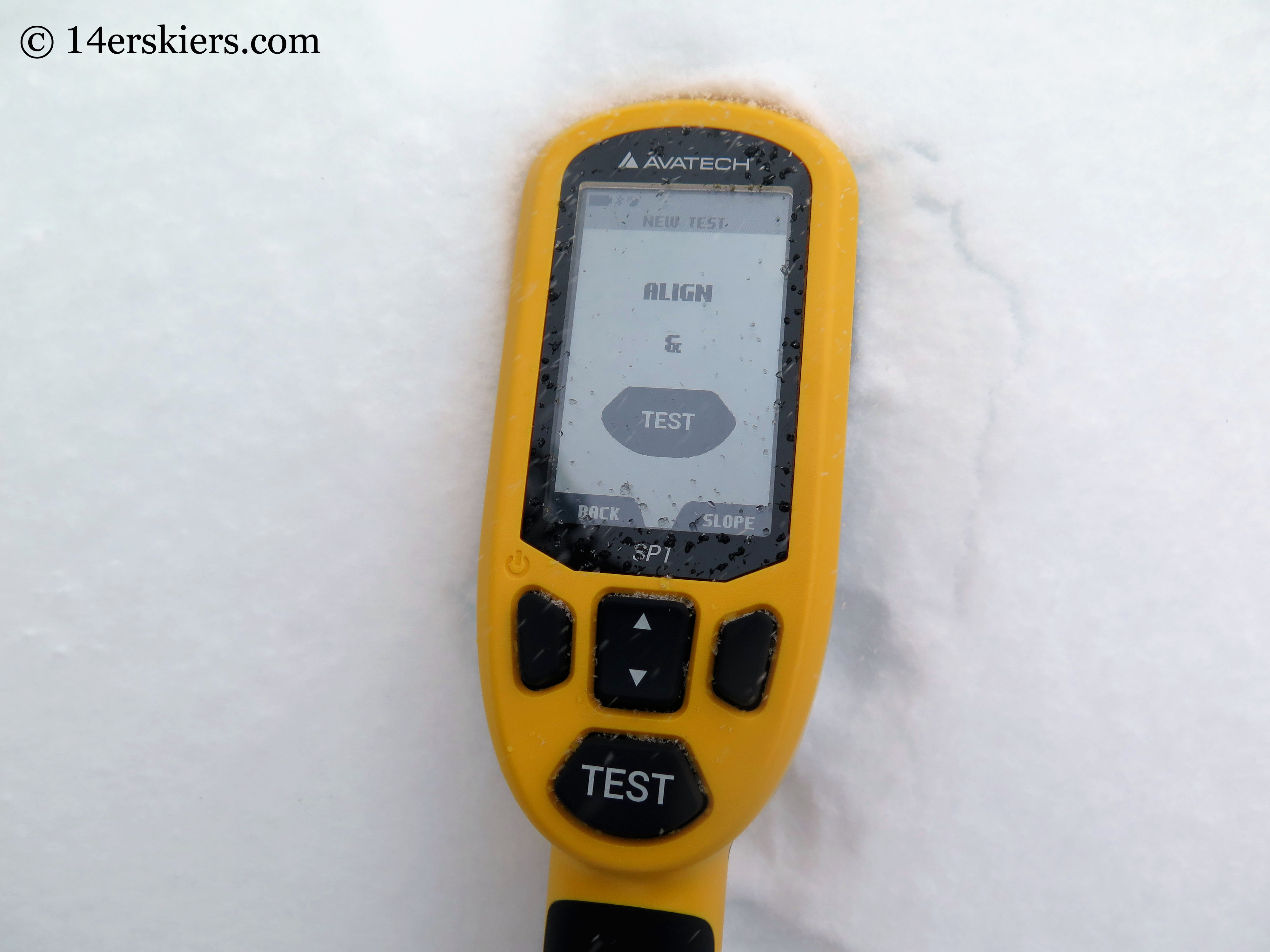Avatech SP1 Smartprobe Review
(Last Updated On: June 16, 2015)
The Avatech SP1 Smartprobe and the related Avanet internet platform seek to transform the way avalanche data is collected and analyzed. The list of people working on this project reads like a who’s who of avalanche professionals, engineers, and computer programmers. The technology involved in the design of this tool is truly impressive.
The 2014-15 season saw the SP1 probe placed in the hands of avalanche forecasters, ski guides, and other pros. We were lucky enough here at 14erskiers to get our hands on the probe late in the season. Unlike other Avatech SP1 testers, we are experienced backcountry skiers, but we are not avalanche professionals.

How the Avatech SP1 Smartprobe Works
The probe works by measuring the resistance of the snow when it is plunged into the snowpack. A depth meter, combined with sensors within the probe, produce a visual representation of the snowpack on the screen of the probe. The results should look familiar to anyone who has looked at snowpack profiles before. What is impressive is that the device doesn’t just match the results of a hand-dug pit profile, in many cases it will pick up on layers that a human observer may miss. The screenshots below compare a professionally dug handpit with a similar SP1 “pit”, both collected on the same date and in the same area:
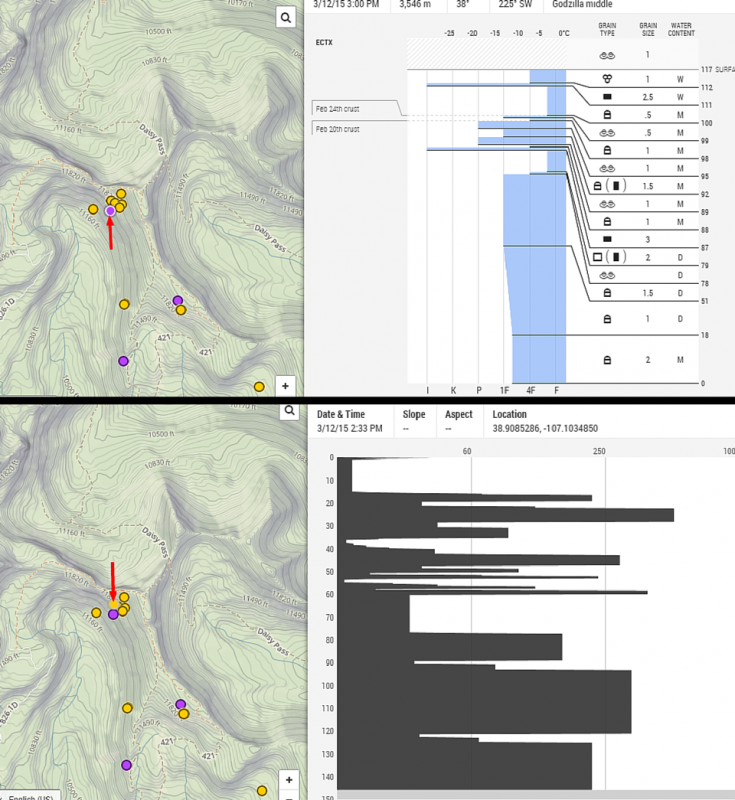
The probe results can be instantly uploaded into the Avanet system in areas with cell coverage (and a phone with bluetooth capabilities). The integrated GPS automatically loads the location that correlates with the data. In areas without coverage, the same data can be uploaded later via computer. Users can choose to upload specific probe tests, or they can upload all their tests. Users can also upload notes, perhaps clarifying the exact position of the probe (“north side of ridge”), or about a problem layer that you’re tracking.
What is Avanet?
The Avanet website is a place for avalanche professionals to upload snowpit data, and it’s also where SP1 profiles can automatically be uploaded. Wondering how snowpits have changed on north faces over the course of the winter at altitudes over 10,000′ in Colorado? You can filter the results to find that information through Avanet. It’s a worldwide system, and we’ve had fun looking at results in Europe for curiosity’s sake. Here’s a look at Colorado profiles this winter- notice how certain areas have a cluster of info, while other areas such as the Sangre de Cristos, have no information at all. Of course, many pits are simply not uploaded onto Avanet for whatever reason.
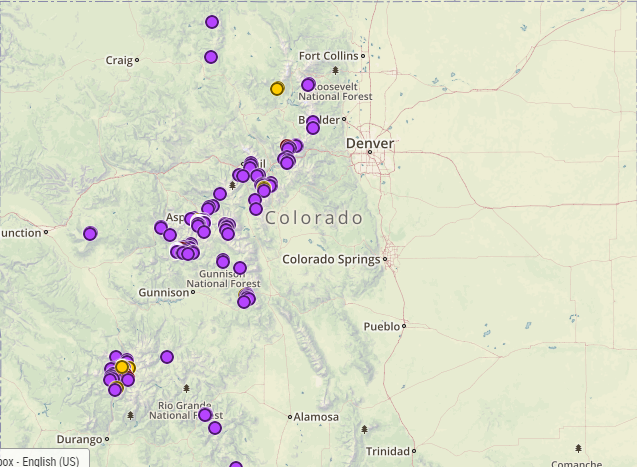
Zooming closer in, here’s a look at the Crested Butte zone. Purple dots indicate hand pits, while the yellow ones are SP1 results. Notice that the large majority of information is centered on the Irwin catskiing area and Crested Butte Mountain Resort.
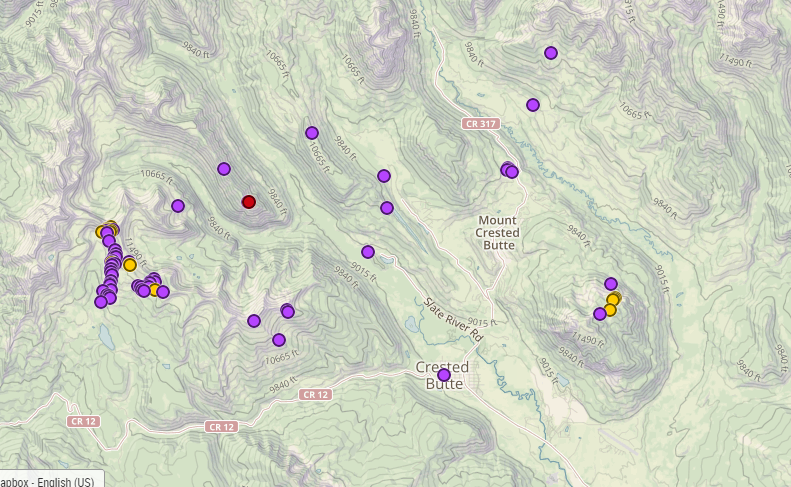
For the 2015-16 season, Avanet will expand to have two versions. The free version will be available to recreational users. A paid version, with additional features, will also be available next year. The professional version will allow for filtering of recreation users by education level, or filtered out all together. Additional pro features include: advanced terrain visualization, new standard observation categories, route planning and sharing, red flag heat mapping, and weak layer tracking analytics.
Using the Avatech SP1 Smartprobe
Using the probe is easy. The key is to probe smoothly, which can take a few tries when there are noticeably harder layers in the snowpack. That’s one of the keys to the probe. In the time it would take to dig one hand pit, the SP1 can be deployed multiple times, providing more information. Experienced backcountry skiers and avalanche professionals know the concept of spatial variability when it comes to snowpacks. In a matter of mere feet, a snowpack can go from looking good to looking scary. A fast device like the SP1 probe allows a user to gather multiple data points, instead of just one or two pits while on a tour.
The photo below is of a SP1 screen in May, 2015 in Colorado. The weather had been unsettled, leading to multiple layers of new snow and suncrusts, which are clearly visible on the screen.
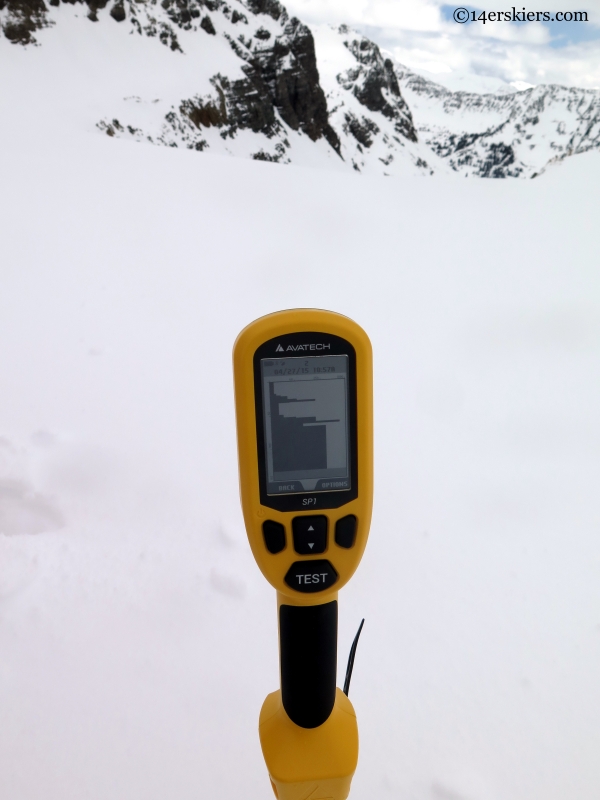
Slope angle is another easy measurement to take with the SP1:
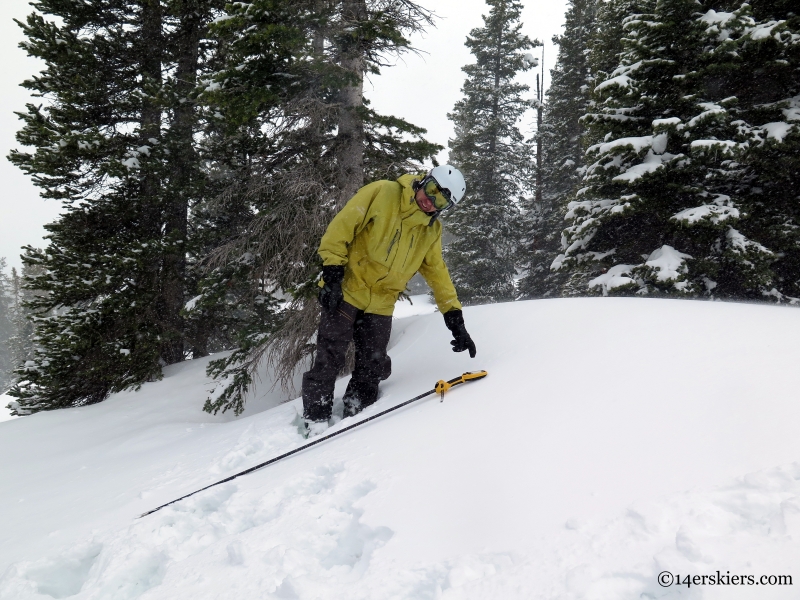
For more on the use of the SP1, please watch the video below:
Our Take on the Avatech SP1 Smartprobe
Our use of the SP1 has been impressive thus far. The probe quite simply works- it picks up layers at least as well as a forecaster, let alone a recreational user. The tests are remarkably reliable and repeatable within the same zones. And the results correlate well with hand-dug snowpit data. Users need to understand, however, that the layers only tell half the story, and stability tests are still necessary to complete the picture.
The ability to collect a number of different results in a short amount of time is a big advantage to using the SP1. The average backcountry user will only dig one pit, if they dig one at all. The SP1 should help combat some of the problems of spacial variability when analyzing avalanche conditions. When used in conjunction with other observations, it’s a nice tool to have in the tool chest.
What will be more interesting, in our opinion, is if enough users begin using the device along with the Avanet system to exponentially increase the data that forecasters can use when doing avalanche forecasts. After all, the SP1 gives the same result no matter who is using the probe, so forecasters can trust the results a bit more than the average user digging a hand pit, with an unknown skill level. As shown in some of the screenshots above, forecasts often rely on results that may be in concentrated areas- if users are uploading data in additional areas of a forecast zone, this should also be a big boon to forecasters.
At a price tag of at least $1,500, the question will remain- how many users will buy this device? It’s certainly unlikely that the average ski bum that skis every day will pay that kind of money for one. Like other tech products, it’s reasonable to assume that the price will drop in the future- but how much? Perhaps avalanche centers will be able to provide them to certain highly active members of the skiing community, with the hopes of getting more data for their forecasts.
Regardless, it’s all conjecture at this point, because the SP1 and SP2 will only be available for avalanche professionals during the 2015-16 season. There are no concrete plans for releasing the probe for recreational users at this time.
Professional Avatech SP1 Smartprobe Review:
by Zach Guy, Lead forecaster for the CBAC and assistant snow safety director for Irwin Backcountry Guides
I’ve had the opportunity to work with the SP1 Probe a handful of days this past winter, both at Irwin and in the backcountry. It is an exciting new tool and a great resource for the snow science community.
Let’s jump straight into the pros and cons of the SP1 Probe, which measures and displays the resistance (essentially the hardness) of the snowpack. In my experience, the probe was quite accurate when compared to hand hardness profiles that we conducted side-by-side. It typically gives a higher amount of detail than my hand profiles, and it commonly identified hardness changes that I missed in my hand profiles. The probe is intuitive and easy to use; it takes a little practice to get the technique dialed in, but luckily it identifies poor probe strikes and will give you an error message if your form is off. I found that in most cases, a couple of attempts were enough to produce a satisfactory profile. It can be challenging to maintain a steady probing speed on crusty south aspects as it punches through ice layers, which frequently called for multiple attempts before it would accept my profile. With the press of a button, you can quickly log slope angles to your profiles. The automatically-logging GPS function is brilliant; allowing all of the profiles to be viewed in a geospatial context later when you upload them to Avanet (the accompanying online software which maps profiles and allows users to add snow profile data into a geospatial and query-able database). The results from your profiles can be instantly viewed and organized on the probe’s screen. The probe folds down into a nice, sleek package that packs around easily, about twice the volume of a standard avy probe. All around, it is a thoughtfully designed device. (Would you expect any less from a team of engineers from MIT?)
This isn’t the first instrument to measure snow resistance. Professionals and researchers have used tools such as the Ramm Penetrometer and the Snow Micropenetrometer, but the SP1 probe is more of a practical tool by many leaps and bounds. These other tools were either far more expensive, too burdensome to carry in the field, much more time consuming or prone to errors, and often required hours of number crunching or data processing to produce a profile after you had returned home. The SP1 is a game changer. With my limited use of the SP1 Probe this past winter, we found it useful for monitoring slab size and extent across terrain features, the presence and absence of certain weak layers, the thickness and variability of different crust layers, and later in the spring, the depth and quality of overnight refreezes. It helped in identifying the best placements for targeted stability tests or full snow profiles. I’ve used my avalanche probe to accomplish all of these tasks in the past, and feeling the snowpack with your own hands should not become a lost art. But the SP1 looks to bring a more quantifiable, accurate, and precise approach to probing the snow.
I haven’t used the probe long enough to put it through the full ringer, but I’ve noticed a few limitations. The probe is only 145 cm long. While most human triggered avalanches occur on weak layers in the upper meter of the snowpack, we almost always deal with basal weak layers in Colorado, and it is rare that I don’t dig down the ground when I’m conducting snowpack assessments. This often means going 150 to 200 cm deep. Secondly, the rubber O-ring on the tip of the probe, which helps protect the sensor, broke somewhat frequently. The guys at Avatech are aware of the problem and sent a bunch of extra O-rings which are easy to replace, and they are in the process of engineering an improved O-ring. [14erskiers note: The o-ring problem has been fixed with the upcoming SP2, which has a new tip design that eliminates the use of o-rings altogether.]
For professional users, the SP1 Probe is hands-down a great tool. For recreational users, I think it is also a nice addition to the backcountry kit, but it depends on your level of experience and how you intend to use it. The probe doesn’t replace sound judgment and terrain management skills: it supplements your decision making with additional observations. The SP1 provides a lot of detail, and it can be difficult to interpret at times. When confronted with information overload, we humans respond by shutting down our cognitive skills and instead take short cuts. In the avalanche world, we call these human factors or heuristic traps: blips in reasoning because our brains don’t want to process all of the info. Sometimes, simple is better, and the probe shouldn’t replace key field observations (avalanche activity, cracking, collapsing, etc) or unstable snowpack tests, which give less room for misinterpretation. The SP1 is best used to strategically extrapolate a thorough understanding of the snowpack to new terrain or monitor for subtle changes in the snowpack as you travel, not to blindly probe around en route to your line hoping the probe will give you a go or no-go decision. If it came down to a conflict of budget, I would prefer to see backcountry users invest their money towards an avalanche course over the probe. A holistic approach to decision-making, with an emphasis on terrain management, is more sustainable than focusing on pin-point observations, some of which may provide an overwhelming or confusing amount of detail. If the SP1 Probe is used to compliment your well-honed skill set and knowledge of the snowpack, then it can be a very powerful and useful tool.
Avatech SP2 Smartprobe to be Released in Fall 2015
Next year, Avatech will release the SP2, an updated version of the SP1 with additional features which include: improved GPS lock and speed, faster bluetooth connectivity, LCD backlit screen for operating in the dark, multiple language options (English, French, German, Italian), enhanced user experience and data visualization, and the ability to tag slope and aspect.
If you want to purchase the SP2, you must pre-order it by Sept. 1, 2015. But, you’re better off ordering it before June 30th as the prices will then increase. The SP2 is $1599 if ordered before June 30th, then $1699 until July 30th, and $1799 after August 1st. Prices include a free year of a professional Avanet subscription ($499 value).
Conclusion
The Avatech SP1 and SP2 Smartprobes, along with the Avanet program, are poised to change the way avalanche forecasters collect and analyze data. The probe largely eliminates human error and judgement in terms of snow layers, and forecasters can easily track a known weak layer across terrain features. Those layers still need investigation, to determine what hazards they might pose- which means that hand pits aren’t about to go away. But forecasters may be able to go on a tour and end up with 10 or 20 points of information, where before it might have only been 2 or 5. More information is always a good thing when it comes to studying something as dynamic as avalanche conditions.
Will high-tech probes like the SP1 ever become part of the recreational user’s pack? That remains to be seen, and the device will need to be released to the public first, before anyone can even think of adopting the technology. Our feeling is that backcountry skiers a few years from now will be carrying devices like this, as another tool in their decision making process.
Frank Konsella
Latest posts by Frank Konsella (see all)
- Bluebird Backcountry Ski Area - February 14, 2020
- Gear Review: Smith 4D MAG Goggles - January 6, 2020
- Gear Review: LEKI Tour Stick Vario Carbon Ski Poles - December 9, 2019
